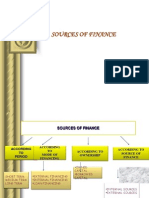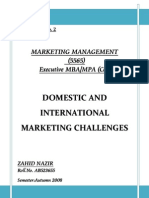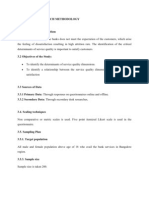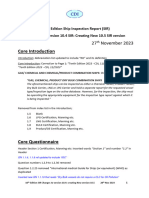Competency Approach To Job Analysis
Competency Approach To Job Analysis
Uploaded by
sumeet7770Copyright:
Available Formats
Competency Approach To Job Analysis
Competency Approach To Job Analysis
Uploaded by
sumeet7770Original Title
Copyright
Available Formats
Share this document
Did you find this document useful?
Is this content inappropriate?
Copyright:
Available Formats
Competency Approach To Job Analysis
Competency Approach To Job Analysis
Uploaded by
sumeet7770Copyright:
Available Formats
COMPETENCY APPROACH TO JOB ANALYSIS
There is a growing interest in focusing on the competencies that individuals need in order to perform jobs, rather than on the tasks, duties, and responsibilities composing a job. This shift emphasizes that it is the capabilities that people have that truly influence organizational performance. As E.E. Lawler suggests, instead of thinking of individuals having jobs that are relatively stable and can be written up into typical job descriptions, it may be more relevant to focus on the competencies used. Competencies are basic characteristics that can be linked to enhanced performance by individuals or teams of individuals. VISIBLE AND HIDDEN COMPETENCIES Knowledge, being more visible, is recognized by many employers in matching individuals to jobs. With skills, although some are evident such as skill in constructing financial spreadsheets, others such as negotiating skills, may be less identifiable. But it is the hidden competencies of abilities, which may be more valuable, that can enhance performance. For example, the abilities to conceptualize strategic relationships and to resolve interpersonal conflicts are more difficult to identify and assess. A growing number of organizations are using some facets of competency analysis. A survey of over 200 organizations sponsored by the American Compensation Association (ACA) asked about the major reasons that firms have used the competency approach. The three primary reasons given were (1) communicating valued behaviors throughout the organization; (2) raising the competency levels of the organization; and (3) emphasizing the capabilities of people to enhance organizational competitive advantage. Many earlier efforts to use competencies have been job-based, meaning that competencies are identified in the context of specific jobs. In this way the competency approach is a logical extension of traditional job analysis activities. However, some organizations are taking the competency approach to another level by focusing on role-based competencies. This shift has been accentuated by the growing use of work teams, whereby individuals move among tasks and jobs. Some of the roles might be leader, supporter, tactician, technical expert, administrator, or others. Through competency analysis, the competencies needed for individuals playing different roles in work teams can be identified. Then selection criteria, development activities, and other HR efforts must be revised to focus on the different sets of competencies needed for the various roles. COMPETENCY ANALYSIS METHODOLOGY Unlike the traditional approach to analyzing jobs, which identifies the tasks, duties, knowledge, and skills associated with a job, the competency approach considers how the knowledge and skills are used. The competency approach also attempts to identify the hidden factors that are often critical to superior performance. For instance, many supervisors talk about employees attitudes, but they have difficulty identifying what they mean by attitude. The competency
approach uses some methodologies to help supervisors identify examples of what they mean by attitude and how those factors affect performance. Several methodologies are available and being used to determine competencies, with behavioral event interviews being commonly found. This process involves the following steps: 1. A team of senior managers identifies future performance results areas critical to the business and strategic plans of the organization. These concepts may be broader than those used in the past. 2. Panel groups are assembled, composed of individuals knowledgeable about the jobs in the company. This group can include both high- and low-performing employees, supervisors, managers, trainers, and others. 3. A facilitator from HR or an outside consultant interviews the panel members to get specific examples of job behaviors and actual occurrences on the jobs. During the interview the individuals are also asked about their thoughts and feelings during each of the described events. 4. Using the behavioral events, the facilitator develops detailed descriptions of each of the competencies. This descriptive phase provides clarity and specifics so that employees, supervisors, managers, and others in the organization have a clearer understanding of the competencies associated with jobs. 5. The competencies are rated and levels needed to meet them are identified. Then the competencies are specified for each of the jobs. 6. Finally, standards of performance are identified and tied to the jobs. Appropriate selection screening, training, and compensation processes focusing on competencies must be developed and implemented. Examples of the competencies used in organizations vary widely. In one survey of 10 companies, the following were most common: -Customer focus -Leadership -Team orientation -Innovation -Technical expertise -Adaptability -Results orientation
You might also like
- Teleological EthicsDocument12 pagesTeleological Ethicsdramariavasquez1979No ratings yet
- Job Satisfaction Case StudiesDocument7 pagesJob Satisfaction Case Studieshusna11No ratings yet
- Strategic Management-Chapter 1 & 2Document10 pagesStrategic Management-Chapter 1 & 2rumelrashidNo ratings yet
- Olympus - Delta User ManualDocument124 pagesOlympus - Delta User ManualOscar PalacioNo ratings yet
- Conference PresentationDocument14 pagesConference Presentationapi-551973446No ratings yet
- Resolving Constraints in Collaborative Procurement Through The Lens of A Portfolio Purchasing Model: A Traditional Literature ReviewDocument17 pagesResolving Constraints in Collaborative Procurement Through The Lens of A Portfolio Purchasing Model: A Traditional Literature ReviewShumank SrivastavaNo ratings yet
- Sunil Testing HypothesisDocument39 pagesSunil Testing Hypothesisprayag DasNo ratings yet
- Solved Examples Ch10Document8 pagesSolved Examples Ch10aman_nsuNo ratings yet
- Scope of Human Resource ManagementDocument2 pagesScope of Human Resource ManagementRoshni NarayananNo ratings yet
- HRD For WorkersDocument24 pagesHRD For WorkersTarak JainNo ratings yet
- Student Resource - Case StudiesDocument32 pagesStudent Resource - Case StudiesGenie Soriano100% (1)
- Porter's Five Forces ModelDocument3 pagesPorter's Five Forces ModelDokte Baulu Bangkit100% (1)
- IGNOU MS-02 Solved Assignments Jan - June 2013 2Document22 pagesIGNOU MS-02 Solved Assignments Jan - June 2013 2abdultvm2000No ratings yet
- AssignmentDocument13 pagesAssignmentmbahmaniNo ratings yet
- Syllabus Bolton UniversityDocument5 pagesSyllabus Bolton UniversityPhuongChiNo ratings yet
- Major ReportDocument13 pagesMajor ReportYashpal SinghNo ratings yet
- Human Resource ManagementDocument7 pagesHuman Resource ManagementAzmaria AzmanNo ratings yet
- MPO NotesDocument24 pagesMPO NotesBrandon RaoNo ratings yet
- Lecture Notes Session 7Document37 pagesLecture Notes Session 7Paramjit SinghNo ratings yet
- A969248439 - 23974 - 11 - 2018 - Art Deco ExpressionismDocument19 pagesA969248439 - 23974 - 11 - 2018 - Art Deco ExpressionismNazimNo ratings yet
- Brand Decisions: Prof. Smitha Sarma RanganathanDocument35 pagesBrand Decisions: Prof. Smitha Sarma RanganathanTinku KourNo ratings yet
- Sources of FinanceDocument16 pagesSources of FinanceVinay CHNo ratings yet
- Leadership: "Trust Men and They Will Be TrueDocument26 pagesLeadership: "Trust Men and They Will Be TrueApoorva Tripathi100% (1)
- Contribution of Management ThinkersDocument12 pagesContribution of Management ThinkersSakharam Dhande100% (3)
- Industrial ConflictDocument30 pagesIndustrial ConflictSownthariya TNo ratings yet
- HRM Lecture 1Document31 pagesHRM Lecture 1Latif Masih FAST NU LHRNo ratings yet
- Ba5105 Organizational Behaviour 2 Marks Questions Unit - I 1. What Is OB?Document19 pagesBa5105 Organizational Behaviour 2 Marks Questions Unit - I 1. What Is OB?Rajesh Arumugam100% (1)
- Domestic & International Marketing ChallengesDocument27 pagesDomestic & International Marketing ChallengesZahid Nazir50% (6)
- Assignment - DBB1203 - BBA 2 - Set 1 and 2 - March 23Document9 pagesAssignment - DBB1203 - BBA 2 - Set 1 and 2 - March 23Entertainment HubNo ratings yet
- Capstone Project Handbook - V1.1 March 2024-FinalDocument18 pagesCapstone Project Handbook - V1.1 March 2024-Finalxain khanNo ratings yet
- War For TalentDocument26 pagesWar For TalentPeeyush ModiNo ratings yet
- Mpo Exam NotesDocument20 pagesMpo Exam NotesAnika RoseNo ratings yet
- Organization Behaviour NotesDocument35 pagesOrganization Behaviour Notesjansami22100% (1)
- Industrial Relations - Unit - 1Document7 pagesIndustrial Relations - Unit - 1ravideva84No ratings yet
- Role Efficacy LabDocument5 pagesRole Efficacy LabJyoti DaveNo ratings yet
- Assignment Brief OB A1 - 17BMDocument7 pagesAssignment Brief OB A1 - 17BMMinh LợiNo ratings yet
- Perspectives On Industrial RelationsDocument3 pagesPerspectives On Industrial RelationsKarnajit RkNo ratings yet
- Antecedents and Consequences of Sustainable Human Resource ManagementDocument4 pagesAntecedents and Consequences of Sustainable Human Resource ManagementMubashir AnwarNo ratings yet
- Topic 2 - Human Resource PlanningDocument14 pagesTopic 2 - Human Resource PlanningMAWIIINo ratings yet
- Transactional Analysis - Johari Window - OBDocument28 pagesTransactional Analysis - Johari Window - OBM.MONIKANo ratings yet
- III HR PlanningDocument34 pagesIII HR PlanningsupratamNo ratings yet
- Robbins - Ob14 - Tif01 3Document51 pagesRobbins - Ob14 - Tif01 3Eddie Lu100% (1)
- B1-Sec1-Engstrom Auto Mirror PlantDocument12 pagesB1-Sec1-Engstrom Auto Mirror PlantJamie Ross100% (3)
- Chapter IIIDocument4 pagesChapter IIIDilip MargamNo ratings yet
- Investment Perspective of Human ResourcesDocument20 pagesInvestment Perspective of Human ResourcesNarender SainiNo ratings yet
- Chapter 3 Corporate ResponsibilityDocument32 pagesChapter 3 Corporate ResponsibilityHairizal Harun100% (1)
- HRMDocument3 pagesHRMMehedi HasanNo ratings yet
- 2 - Foundation of Individual Behavior Organisational BehaviourDocument27 pages2 - Foundation of Individual Behavior Organisational Behaviourrohan_jangid8No ratings yet
- Case Study AnswerDocument10 pagesCase Study AnswerpreetimutiaraNo ratings yet
- Business Ethics PresentationDocument22 pagesBusiness Ethics PresentationMohit ManaktalaNo ratings yet
- CHAPTER 1 Perspective ManagementDocument13 pagesCHAPTER 1 Perspective ManagementBabu MertiaNo ratings yet
- Business Research Methods Chapter 04Document4 pagesBusiness Research Methods Chapter 04Soumya Jyoti BhattacharyaNo ratings yet
- Nature & Scope of HRMDocument26 pagesNature & Scope of HRMhahire100% (3)
- Organisational CultureDocument10 pagesOrganisational CultureUmer EhsanNo ratings yet
- Group3 SemiconIndiaDocument12 pagesGroup3 SemiconIndiaSULOCHNA KUJURNo ratings yet
- Managing Britannia: Culture and Management in Modern BritainFrom EverandManaging Britannia: Culture and Management in Modern BritainRating: 4 out of 5 stars4/5 (1)
- Global Corporate Entrepreneurship: Perspectives, Practices, Principles, and PoliciesFrom EverandGlobal Corporate Entrepreneurship: Perspectives, Practices, Principles, and PoliciesNo ratings yet
- SOP Privacy & Confidentiality (Rev) PDFDocument3 pagesSOP Privacy & Confidentiality (Rev) PDFRudy Ume Hartono100% (1)
- Pre Requisite: BE 100 Engineering MechanicsDocument3 pagesPre Requisite: BE 100 Engineering MechanicsBalagopal VNo ratings yet
- BIOCOMPATIBILITY of DMDocument48 pagesBIOCOMPATIBILITY of DMShalu Mondal100% (1)
- ABG Lecture PDFDocument11 pagesABG Lecture PDFbianca maaliwNo ratings yet
- Manual Transmission: To IndexDocument33 pagesManual Transmission: To IndexDwi Rizky Febriyanto IpepNo ratings yet
- Analytics 2023 01 02 020022Document191 pagesAnalytics 2023 01 02 020022stancristian2010No ratings yet
- Why MySQL Could Be Slow With Large TablesDocument14 pagesWhy MySQL Could Be Slow With Large TablesArisetty Sravan KumarNo ratings yet
- T3 - Fluid Mechanics - CH2Document24 pagesT3 - Fluid Mechanics - CH2roi constantineNo ratings yet
- Module Title: Mechanical Materials (3D) : MECH8012Document4 pagesModule Title: Mechanical Materials (3D) : MECH8012Maurício SouzaNo ratings yet
- Is Alan Roger Currie "The G.O.A.T." of All Dating Coaches For (Single) Men?Document2 pagesIs Alan Roger Currie "The G.O.A.T." of All Dating Coaches For (Single) Men?PR.comNo ratings yet
- How To Use Your Reading in Your Essays Third EditionDocument208 pagesHow To Use Your Reading in Your Essays Third Editionbunthy loch100% (1)
- Fundamental AnalysisDocument20 pagesFundamental AnalysisMaria FlorinaNo ratings yet
- JavaServer FacesDocument4 pagesJavaServer FacessohelsunNo ratings yet
- Ammonia Refrigent Advantages and DrawbacksDocument14 pagesAmmonia Refrigent Advantages and Drawbackskvsj2001No ratings yet
- USACO Platinum Problem 1 December 2021Document1 pageUSACO Platinum Problem 1 December 2021Bob JohnsonNo ratings yet
- DustMate Operating Instructions PDFDocument32 pagesDustMate Operating Instructions PDFsaraNo ratings yet
- NCA Lab Guide - StudentVersionDocument22 pagesNCA Lab Guide - StudentVersionSaid bel haj letaiefNo ratings yet
- CDI 10th Edition 10.5 2023 - Changes To 10th Ed SIR 10.4 To 10.5Document12 pagesCDI 10th Edition 10.5 2023 - Changes To 10th Ed SIR 10.4 To 10.5nguyentrucduy677No ratings yet
- Os LabDocument5 pagesOs LabVIRIYALA MANASA 21BCE7449No ratings yet
- Effect of The Traditional, Charmat and Asti Method Production On The Volatile Composition of Moscato Giallo Sparkling WinesDocument8 pagesEffect of The Traditional, Charmat and Asti Method Production On The Volatile Composition of Moscato Giallo Sparkling WinesDeivid Silva de SouzaNo ratings yet
- Be FR NLDocument198 pagesBe FR NLNaltu IonelNo ratings yet
- Prospectus PDFDocument19 pagesProspectus PDFAbhishekNo ratings yet
- Internship in MissionEdDocument2 pagesInternship in MissionEdschtiksNo ratings yet
- Human FactorsDocument69 pagesHuman Factors2009tamerNo ratings yet
- APAC - Literature - Coating - Epoxy Resin & Hardeners For Coating Selector Guide PDFDocument10 pagesAPAC - Literature - Coating - Epoxy Resin & Hardeners For Coating Selector Guide PDFraahul_nNo ratings yet
- FM FinalDocument87 pagesFM FinalGaurav S JadhavNo ratings yet
- King I. Phillips Despite: Department of Microbiology, ST Thomas's Hospital Medical School, London SEI 7EHDocument12 pagesKing I. Phillips Despite: Department of Microbiology, ST Thomas's Hospital Medical School, London SEI 7EHLeandro LopezNo ratings yet
- LP Math - Comparing DecimalsDocument7 pagesLP Math - Comparing Decimalsapi-422257454No ratings yet
- Popular Science October 2015Document84 pagesPopular Science October 2015OnyxNo ratings yet

























































































